How to solder polypropylene pipes
Many owners of houses and apartments during repairs often decide to replace existing worn-out pipelines with new modern analogues from polypropylene material. Such pipeline products have the following advantages over metal pipes:
- no possibility of corrosion;
- good performance at high pressures and temperatures;
- thanks to modern technologies of soldering polypropylene pipe products, it is provided for ease of installation in the home;
- resistance to mechanical stress;
- affordable cost.
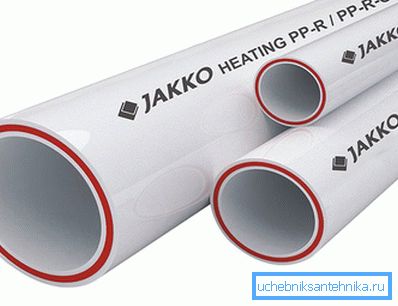
With high-quality installation of polypropylene pipes and their proper operation, they can serve for a long time and reliably. Anyone who has decided to make a major overhaul, which, in addition to many other jobs, involves replacing old pipes with new ones, will have to learn how to solder polypropylene pipes. Having the appropriate tools and equipment, as well as having certain knowledge, it will not be so difficult to do this work.
A tool for polyfusion soldering of polypropylene pipes
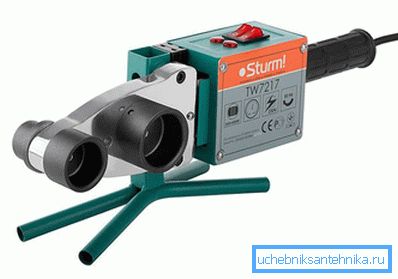
Soldering of polypropylene pipes is impossible without a special tool. For home soldering, you can purchase an affordable simple soldering iron, which is sold in many hardware stores. It has a heating element power of 800 watts. If you solder pipes for heating or plumbing, then this power is enough.
You also need to know at what temperature the product should be soldered. The main task of the soldering iron is to heat the connected polypropylene pipe ends to a temperature of 260 ° C. At this temperature, diffusion welding occurs, which forms a one-piece connection with properties identical to the pipe material.
Tip! The power of the soldering iron determines only the heating rate of the element. The soldering process does not depend on this parameter.
Classic household soldering irons are completed with nozzles for pipes of the most common diameters - 20, 25 and 32 mm. To work with pipelines in the house or apartment can be limited to this range. If it turns out that they are not enough, the nozzles can be purchased additionally. A special feature of the nozzles is the presence of a Teflon non-stick coating that prevents polypropylene from sticking during soldering.
When buying a soldering tool you should pay attention to the following parameters:
- The handle should be comfortable, which will facilitate the work on the weight. The design of this important part of the tool should protect the master from burns.
- When soldering in stationary conditions, the stability of the soldering iron must be ensured with the help of a reliable stand.
- Household tools for soldering should have two power regulators, when switching which will change the heating temperature of the working element. Temperature adjustment in professional soldering iron occurs smoothly, which allows you to more accurately set the temperature.
- The process of heating the work item must be automated. The automatics should turn on and off the heating in case the temperature exceeds the limits of the set parameters.
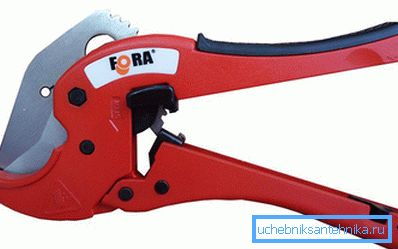
For works on the soldering of pipes from polypropylene one soldering iron will be small. In addition to the soldering iron, you will need special pipe shears, with which with a slight movement of the hand you can cut the pipe in the right place at a right angle and at an angle of 90 °. They are of reinforced construction and can even cut reinforced pipes. Such scissors are present in any kit designed for soldering pipes made of polypropylene material. Reinforced pipes require a special device for working with them - a shaver, with the help of which the chamfer is removed from the workpiece together with aluminum foil. If the metal layer is not removed from the reinforced pipe, it will be impossible to solder the pipe.
Tip! In most sets of soldering tools, there is no shaver for removing foils, so it needs to be purchased separately. Despite the additional expenses arising from the purchase, we advise you not to give up the purchase. The shaver is notable for its durability, and its use will greatly simplify and facilitate the work.
In addition, in some cases, you will need an additional tool for soldering polypropylene pipes:
- measuring tape for measuring work to determine the desired length of the pipe fragment;
- pencil for stamping marks that will be cut;
- hacksaw, which in the absence of pipe shears will perform their function;
- a sharp knife for chamfering the end of the pipe to be soldered;
- acetone or alcohol for degreasing.
Polyfusion Soldering Technology
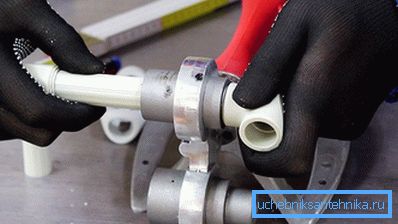
Polypropylene pipes are soldered in a specific order:
- Nozzles of the required diameter are mounted on the working element for heating the soldering iron. If at the same time connecting pipes of different diameters is required, nozzles of the required sizes are put on the tool. When the device is already turned on, it will be impossible to remove and change the nozzles because of the danger of getting burned - you have to wait until the heating element cools down.
- The soldering iron is permanently fixed on the stand and connected to the electrical network. The regulator switches to a heating element temperature of 260 ° C, which is optimal for polypropylene. If the indicator lights are on, it indicates that the device has started to warm up. After the first turn off the indicator after a while it turns on again. Repeated switching off of the light bulb signals the disconnection of the working heating element, which has acquired the optimum heating temperature.

- While the soldering iron is at the desired temperature, it is necessary to carry out preparatory work with pipes that will be subject to soldering. Using a tape measure and a pencil, mark the place where the pipe is trimmed, cut the blanks with pipe-cutting scissors, remove the chamfer with a knife or a special tool and, if it is a reinforced nipple, remove aluminum foil with a shaver. It must be remembered - the metal layer is present only in pipe products, it is not used in fittings. After that, you need to try the parts to be connected to each other, pressing them in a position in which they will be after the spike. This is necessary so that after the end of the operation the shaped parts are turned in the direction in which it is necessary. Beginners sometimes have cases when, after the spikes, the fittings look in a direction different from the planned one.
- After the soldering iron is heated to the desired temperature, the prepared parts are put on the appropriate size of the nozzle. The period of stay of the products on the heating elements depends on the diameter of the pipe and must comply with that specified in the instructions attached to the tool. After the control time has expired, the parts are removed from the soldering iron and are pressed against each other with a confident movement. To the joint was high quality and reliable, the connected parts can not be moved. After docking, the connected elements are left alone for some time, as required by the instructions.

Tip! The pipeline can be operated after complete cooling.
Electro-fitting brazing
Soldering by an electrical fitting differs from a polyfusion compound in that a special coupling assembly is used for its implementation. It is installed at the required place using a special cable-liner.
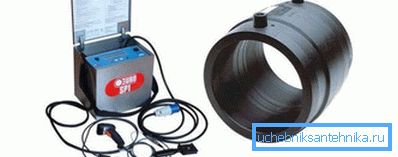
The process of electrofitting soldering is as follows:
- Use a cash tool, the pipes are cut into the pipes of the desired length, determined in advance.
- The pipes are subjected to a final inspection, the unit is brought to working readiness.
- The external surface of the pipes is cleaned from the oxide layer and degreased. The same procedure is carried out by electro-fitting, but from the inside.
- A pencil is made on the pipe, indicating how far it should go into the fitting.
- The nozzle is installed in the electrical fitting and securely fix the parts in a stationary position, as the heated polypropylene increases in volume and tends to slip out of the molded part under the influence of pressure.
- Solder unit is connected to the electrical network and expect the required degree of heating.
- Using the contact wires connect the solder unit with electrical fitting.
- To start the soldering process, press the "start" button. After completion of the process, the machine turns off automatically.
- Whether the soldering process has gone through correctly can be recognized by the inspection points at the fitting, which determine the ejection of the plastic product.
Upon completion of the soldering of polypropylene pipes, the bonding point should be in a stationary position until it cools completely. Cooling the compound should occur naturally. After cooling, the junction in its strength properties will not be inferior to the characteristics of the surface of the tubular product. The docking of the parts must be done in such a way that the seam from both the outer and inner sides does not form scars, which, in use, may impair the carrying capacity. Compounds of polypropylene products compare favorably with steel ones - they are much stronger and more reliable. In fact, any part of the polypropylene piping system can be dismantled and replaced.
Tip! The polypropylene pipeline system can be operated 60 minutes after the last connection has been made. The longer the seam is in a cooling state, the more stress it will be able to withstand. During cooling, the place of adhesion should not be subjected to mechanical stress.
The method of bonding polypropylene pipes using electro-fitting is quite high quality and fast. It far surpasses the method of bonding by diffuse soldering in performance. Not surprisingly, this method is used by large companies that are engaged in the installation of polypropylene pipes in large volumes.
Cold brazing

In addition to the above two methods of connecting polypropylene pipes, the method of cold soldering is used. It is based on the use of aggressive glue:
- preparation and cutting of tubular products is carried out by a method identical to the method of classical soldering;
- pipes and fittings are marked in accordance with the future arrangement of parts, according to the layout;
- the adhesive composition is applied to the place of fastening parts, then they are interconnected and pressed against each other;
- fixation lasts a quarter of a minute.
Tip! Water can be supplied to the installed system no earlier than 60 minutes after the cold soldering of the pipeline.
It should be noted that the adhesive compound in its strength is not worse than the usual soldering. In this way, pipes designed for gas supply systems, hot water supply and heating cannot be connected. They are suitable only for cold water. In other cases, only metal pipelines or polypropylene pipelines, welded by the above methods, are suitable.
Corner soldering
Polypropylene tubulars should only be cut at a right angle. They should be degreased and cleaned in the usual way. Since pipes in the corners should be smooth and effortless, fittings or a clamping device is used during the soldering process. Before starting work in pencil draw a mark indicating the depth of occurrence of pipes. Then polypropylene pipes simultaneously with the angular nozzle is heated to the desired temperature. At the completion of the soldering, the pipe joints should cool down as usual. To a greater extent this applies to parts with thin walls that are easily amenable to mechanical stress.
Soldering in hard to reach places
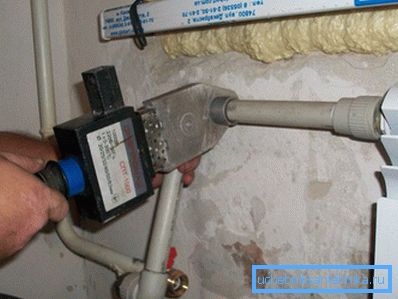
The complexity of such work as soldering polypropylene pipes with their own hands in places that are difficult to reach, is to perform movements that require special precision. In the formation of large or small curvatures, which to a greater extent relate to parts of considerable diameter, the connected elements can be immediately replaced with new ones and qualitatively bonded. Soldering of polypropylene products must be carried out with the unit permanently on, and the heating of the fittings and pipes must be done simultaneously.
Tip! Inadequate and uneven heating of parts can lead to poor-quality connection, which in the future threatens system failure. Overexposing the pipes on the heating element may result in deformation of the tubular and the impossibility of inserting it into a fitting or clamping device in hard-to-reach places.
Common mistakes
If, during the soldering of a pipe made of polypropylene and a shaped part, the pipe product is not inserted before the end stop, the gap that appears, if it is more than one millimeter, between the fitting stop inside and the end of the nozzle will be highly undesirable. On a pipeline system prepared for use, this gap will be a section with a wall whose thickness will be less than necessary. In addition, the internal diameter at the problem site will be less than the pipe diameter as a result of heating on the working element of the soldering iron. This will produce an imbalance between the calculated pressure of the pipe and the real, which will constantly affect the problem area. In the future, this may lead to an emergency.
On the other hand, you can and overdo it by applying force when connecting parts that are subjected to soldering. In this case, between the fitting stop inside and the end of the nozzle, the bridge in the middle of the fitting is squeezed out, which will lead to difficulty in the movement of water or other liquid. On how to properly solder pipes made of polypropylene, you can watch a video that shows all the nuances of the work.